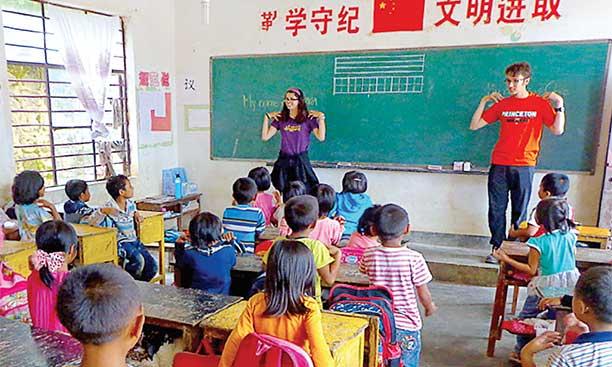
Over the past decade, more than 300 undergraduates have begun their Princeton experiences on a lifetransforming path toward global citizenship. Spending an academic year abroad working alongside community-based service organizations, these students have undergone dramatic personal growth — in perspective, knowledge, and maturity — while learning more about the wider world and developing as leaders. They are Princeton’s Bridge Year scholars.
When the University launched its Bridge Year Program in 2009, our goal was to create a distinctive opportunity for incoming first-year Princeton students to spend their first two semesters engaged in service outside their home countries. Sandra Bermann, Princeton’s Cotsen Professor in the Humanities, chaired a committee that thought carefully about the program’s structure and decided several features would be critical for success. The Bridge Year Program would be tuition-free; it would immerse students in their host communities to deepen their learning about the world and themselves; and it would help students develop an orientation toward service that would shape their Princeton educations and, hopefully, their lives after graduation.
President Shirley Tilghman, Professor Bermann, and I were confident when we launched the program that it would enhance the education we could provide to our students and advance Princeton’s longstanding commitment to service. But we could never have imagined the scale of its impact on the lives of our Bridge Year students, on the communities they have served, and on this University.
Since the program’s inception, Bridge Year students have made outsized contributions to our campus community. They have held countless leadership positions; received numerous honors, including the Pyne Prize, the Martin Dale Fellowship, Gates Cambridge Fellowships, and Rhodes Scholarships; and served as Young Alumni Trustees. Their achievements at Princeton and beyond are remarkable.
Now, thanks to an extraordinary gift from Michael Novogratz ’87 and Sukey Cáceres Novogratz ’89, Bridge Year is a permanent part of our educational program, overseen by the Office of the Dean of the College. The Novogratzes’ generosity has also enabled us to expand the number of students from each incoming class who participate in Bridge Year.
In making the gift to endow and name the program, Michael Novogratz said: “I believe that Bridge Year gives students an incredible opportunity to prepare for their role as leaders of an increasingly interconnected world. At the same time, it offers abundant opportunities for introspection and personal growth. Students return from it with a real sense of purpose, and an interest in being of service to their communities, and to the world. The combination of the stellar Princeton education and a commitment to helping others is powerful.”
I could not agree more. As you read this column, more than three dozen Novogratz Bridge Year students are living in Tiquipaya, Bolivia; Kunming, China; Udaipur, India; Yogyakarta, Indonesia; and Dakar, Senegal. In the months ahead, they will develop deep friendships, navigate challenges, serve communities vastly different from their own, and come to know the world in new ways.
Daniel Shepard ’19 spent nine months as a Bridge Year student in Senegal volunteering with Tostan, a non-governmental organization that seeks to empower local communities to lead their own development. He said that “the regular moments of reflection and conversations during Bridge Year made me more intentional with my time during my years on campus,” adding that the experience “solidified my motivation to work for purpose and not for profit.” Today, Daniel works for Ceres, a Bostonbased nonprofit committed to transforming the economy for a sustainable future.
Lizzie Martin ’14 *18 participated in the Bridge Year program during its inaugural year. She lived in Varanasi, India, and worked at a school for children and young adults with disabilities. “My experiences through the Bridge Year Program reinforced many of my existing priorities and helped me develop new ones that continue to influence who I am as a person today,” she said. After graduating from Princeton, Lizzie spent two years as a graduate fellow at the U.S. Department of State through the Scholars in the Nations Service Initiative working in the Bureau of International Security and Nonproliferation, at the U.S. Mission to the International Organizations in Vienna, and in the Bureau of Democracy, Human Rights, and Labor. She is now pursuing a Ph.D. focused on political communication at the University of Pennsylvania.
Nina Onyemeziem ’22 spent her Bridge Year in Bolivia, working for Mano a Mano, an organization that supports rural communities through a variety of health, education, and infrastructure projects. “I feel like I take time to understand people a lot more than I used to,” she said. “In Bolivia, our discussions covered topics that definitely brought out differing opinions and while it was hard to swallow some of them, I learned that background and experiences dictate a lot of these opinions.” She said her Bridge Year experience also made her more open to pursuing international experiences and testing her comfort zone.
We are deeply grateful to Michael and Sukey Novogratz for recognizing the transformative power of Bridge Year and ensuring its future for generations of Princetonians to come. The University, and the world, will be all the better for it.
